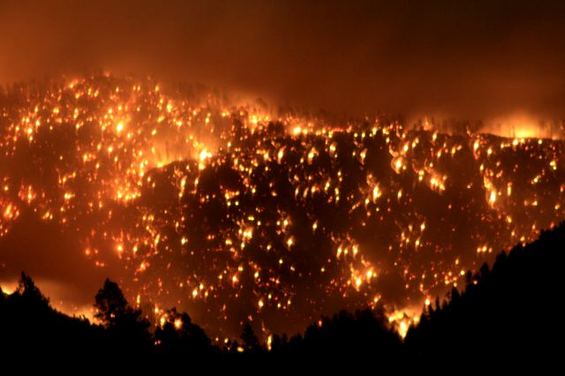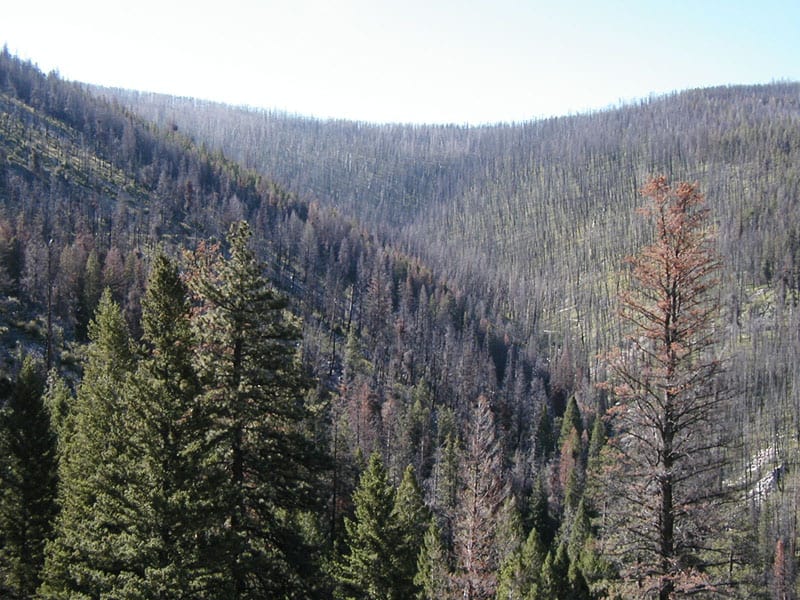Emily Guerin posted this on the High Country News Goat Blog. Here is an excerpt.
The team from Wyoming rounded out their studies by criticizing common forest management practices. Except where necessary to protect homes, they believe widespread culling of small trees and understory shrubs to thin forests, the doctrine behind projects like Arizona’s ambitious 4 Forest Restoration Initiative, is a bad idea. This strategy, they say, will “move dry forests outside their historical range of variability, rather than restore them, probably with negative consequences for biological diversity.”
I can hardly believe that they are still attached to the concept of HRV; however, I understand if you’re a historic vegetation ecologist, it is difficult to let go of that concept. Why do they care so much (being from Wyoming.. about intervening in Arizona?).
Baker doesn’t disagree with Swetnam’s argument that current climate conditions are likely to make modern fires worse. He and Williams just hope to place the current rash of wildfire in its historic context. Big, severe wildfires are “a natural part of our forest ecosystems; we maybe didn’t know that until recently. But now that we do we just have to figure out how to live with that.”
I agree we have to live with current conditions, but also think we need to be clear in our logic as to exactly why we think the past is relevant. It seems like they are saying “we need to do things that are like the past.”
There were a couple of interesting comments also. like this..
Rather than surveyors’ reports, I would put more trust in photographic studies such as Yellow Ore, Yellow Hair, Yellow Pine, which compared multiple photos of the Black Hills taken from the same spots in 1874 and 1974. You can really see how much thicker those ponderosa pine forests became over 100 years
And this exchange between Baker and
We appreciate HCN covering this topic, which obviously is controversial, but there is certainly a need for more research and more public discussion. There is much at stake, as these forests are among our most beautiful western forests, they are near many of our communities, fires are burning out of them into our communities, and there is no doubt that they are in need of ecological restoration after a century of intense logging and livestock grazing. Our research differs, however, in providing distinct messages that we hope will be carefully considered by scientists and the public. The evidence we have published shows that these forests historically burned at high-severity, meaning a large fraction of trees were killed. This occurred when fuels were at natural levels, before any of the widespread EuroAmerican land uses altered these forests. The implication is that today’s fuel-reduction programs that promise to restore fuels to their natural levels likely may not work, since severe fires were common when fuels were at these natural levels. Inside or near ponderosa pine forests or dry mixed-conifer forests thus are really bad places to live, even if fuel-reduction has been undertaken. Alternative approaches for western communities to protect themselves are in my book: Baker, W.L. 2009. Fire ecology in Rocky Mountain forests. Island Press, Washington, D.C.
Dr. Brown’s comment about creationists is just sour grapes, probably because he does not like the findings of our research. He knows very well that our research is published in top, peer-reviewed scientific journals, the same kinds of scientific journals where he publishes. These scientific journals do not publish creationism. The journals are well-respected, including Ecological Monographs and Ecosphere, published by the Ecological Society of America. Our research was funded by the National Science Foundation and the U.S. Department of Agriculture, which have extremely competitive peer-reviewed grant programs. Dr. Brown’s comment is unfounded and also denigrating to the scientific enterprise in general and the many scientists who contribute to these programs and scientific journals.
Also, the dataset is not tiny, as Dr. Brown implied. There are >13,000 records from the surveyors across about 4 million acres of land in three states in the central study, which is published in Global Ecology and Biogeography (see below). Moreover, the records are as good or better than the kinds of data Dr. Brown and Swetnam rely upon. Even in the most heavily sampled area in Northern Arizona (Abella and Denton 2009), the tree-ring data that form the basis for our study (75 trees/ha) are more abundant than in tree-ring studies (69 trees/ha) and much more abundant than government weather data and government forest-monitoring (FIA) data that are considered a sound basis for scientific understanding of climate and forests. Also, the accuracy and validity of the survey data were validated in an extensive scientific trial, which was published in 2011 in Ecological Monographs, one of the top ecological science journals in the world. Moreover, the tree-ring data that Drs. Brown and Swetnam rely upon are very spatially limited, generally from small, isolated studies totally at most thousands of acres, not millions of acres as in our study.
Dr. Swetnam is incorrect. We published new evidence that the size of high-severity fire patches and the rate of high-severity fire is no different now than it was in a comparable period before EuroAmerican settlement, in natural forests. This study is in Ecosystems (see below).
Readers interested in seeing the actual evidence in these published studies can find them using the citations and links below, but may have to access them via subscriptions, or can email me at [email protected]. Bill Baker
and Peter Brown
I would like to briefly follow up on my comments to Ms. Guerin with first an apology concerning my ill-chosen comparison of this recent work from Drs. Williams and Baker to creationists’ efforts: Certainly W&B are publishing their research in peer-reviewed journal articles and are obviously following scientific methods and ethics, in very strong contrast to the creationists. I sincerely apologize to both Drs. Williams and Baker for that comparison.
However, my point was that we have been here before. This new data set is, in my opinion, just one more in a series of approaches that appears from the outside to be part of an agenda to tear down any efforts – however well-meant, however well-documented – at ecological restoration of surface fire regimes in ponderosa pine ecosystems around the western US. So to my follow-up question about the data presented in their work: Even if their model of forest structure based on the GLO data is correct, there is still a grand leap from there to fire behavior. Current fires in ponderosa have contained large portions of active crown fire, with complete tree mortality over 1000s or even 10000s of acres. Tree recruitment into recent fires on the Front Range (e.g, Black Tiger, Buffalo Ck, Bobcat Gulch, Hayman, etc) as well as many other areas around the SW in particular has been either very slow or nonexistent. Considering the lack of seed sources that have occurred across some very extensive landscapes and the relatively large size and lack of mobility of ponderosa seed, how does the lack of recruitment after recent fires fit with their model of past fire behavior, if the current fires are within the HRV according to this model? Most certainly current forests are not coming back as dense stands of even-aged trees. Right there something is incomplete in the model, and strongly suggests that their interpretations of the GLO data – and hence implications contained in these data for ecological restoration efforts – are flawed.
and of course I enjoy a fellow bringing up evolutionary characteristics of forest trees (after all “ecosystems” don’t evolve; species do)
It is in the best practice of science that widely accepted paradigms are challenged from time to time if for no other reason that it forces us to step back and really examine what we think we know. I think the research mentioned here certainly falls into that category as we work to expand our understanding of fire processes in western ecosystems.
The biggest difficulty I’m having with the conclusions of Drs. Baker and Williams is that it seems counter-intuitive to the evolutionary selection of traits in ponderosa pine — thick bark, fast juvenile growth, and good self-pruning — which seem tailor made for a low-intensity fire regime. As opposed to lodgepole pine — thin bark, early maturation, serotinous cones, poor stem exclusion — which would benefit from an infrequent high-intesity regime. And with mixed-conifer stands the story is more complicated of course, hence mixed-severity regimes being thought of as common in them (with the true firs in areas mostly devoid of fire).
It’s this incongruity that I’m trying to reconcile with the idea that infrequent high-severity fires were the historic norm across a wide array of western forests.
And this historical comment from Clark Stoner:
Although clearly a clever use of GLO notes, I think the GLO survey notes should be read from the point of view of the surveyors who wrote them and in the context of the times.
The GLO surveyors weren’t exactly welcomed guests in those days. The U.S. Government was at war with various indian tribes at various times across the west. There is little doubt that the indians understood the surveyors preceded the western movement of the white man, which they likely considered threatening. The survey parties weren’t exactly all that well paid, and they likely often feared for their safety. So, I would have taken a rather tongue in cheek approach to the reliance of the GLO notes when they were describing the landscape (they most often served future boundary retracement surveyors needs quite well). In my experience with reading GLO notes in California and Nevada, dating back from the 1860s through the 1880s, I find that they weren’t exactly describing forested land in terms of any measurable density. Their descriptions of forested land were actually quite general and subjective. You were taking a gamble if you were a speculator in the GLO office trying to decide whether or not you wanted to buy the land described. So in the study it appears they found quite a number of bearing trees (which is cool), but their existence is no testament to the density of the forest at the time the GLO surveyors marked them.
Also, why is reliance on data from the 1880s so relevant? I seem to recall Lewis and Clark witnessing the indians setting fire to the landscape in 1804, which I believe it is now accepted that the indians were performing their own forestry management practices prior to the arrival of the Europeans, and most agree their practices were to promote fertile hunting grounds. So, as the indians got wrapped up in wars with the U.S. Government, it might be safe to say that their normal forestry management practices were disrupted and in various cases the forests appeared quite different by the time the GLO surveyors arrived. The GLO surveyors in many cases might not have been witnessing the forests in their centuries prior “pre-existing” state (saving the term “natural state”).
There are other interesting comments as well.
Bottom line, many people have interesting perspectives on this and scientific journals and the general press only give us a piece of the story, if left to their own devices. Further, many people’s disciplines and experiences can be relevant from understanding surveyors to tree evolution.
Thanks to Emily for taking this on!



